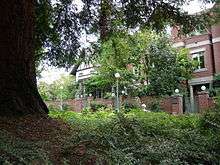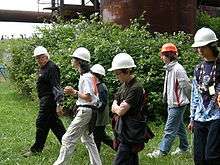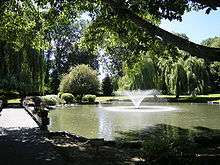Richard Haag

Richard Haag (born October 23, 1923) is a United States landscape architect. He is famous for his work on Gas Works Park in Seattle, Washington and on the Bloedel Reserve on Bainbridge Island. He is also noted for founding the Landscape Architecture Program at the University of Washington and for holding multiple design awards. His designs call to mind the current trend of being one with and improving the environment. Although Al Gore's An Inconvenient Truth is after Richard Haag's heyday, the ideals evoked from the film are shown in his designs. The social movement that created the hybrid car also demanded sustainable design, and Richard Haag provided it in the most distinctive and astounding ways. Richard Haag's modernist and minimalist ideals set the tone for northwestern landscape design and has placed the northwest on the road towards ecologically-minded design.
Richard Haag was born and raised in Louisville, Kentucky. He attended the University of Illinois, the University of California, received his bachelor's degree in Landscape Architecture (B.L.A.) at the University of California, Berkeley, and his master's degree in Landscape Architecture (M.L.A.) at Harvard Graduate School of Design.
Richard Haag's involvement in education did not stop upon the day he received his Landscape Architecture Degree. In 1958 Richard Haag joined the University of Washington faculty in Seattle, Washington in an attempt to start a Landscape Architecture Design program at the university. His efforts resulted in a Landscape Architecture Department by 1964.
At the same time that he was building up the program at the University of Washington, Richard Haag was acting as lead designer at his self-made design company Richard Haag Associates. Through his position at Richard Haag Associates he has generated over 500 designs and planning projects. His company, located in Seattle is still a major firm today.
Notable designs

- Gas Works Park—Seattle
- "Sequence of Gardens" at Bloedel Reserve—Bainbridge Island, Washington
- Battelle Research Center—Seattle
- Victor Steinbrueck Park—Seattle
- Jordan Park—Everett, Washington
- North Waterfront Park—Berkeley, California
- U.S. Courthouse Plaza—Spokane, Washington
- Washington Pass Overlook & Visiting Center—Winthrop, Washington
- Merrill Court Townhomes—Harvard-Belmont Historic District, Seattle
- Okanogan National Forest—Winthrop, Washington
- Gilman Village-Issaquah, Washington
Gas Works Park

In 1906 on a peninsula on the north shore of Lake Union the Seattle Gas Company constructed a coal gas plant. By 1956 the plant was shut down, leaving behind the old refinery towers. Upon purchasing the land in 1970, Haag was the person asked to develop a park design for the site. While most planners had expected the demolition of the refinery towers, Haag decided to keep them†. He did not incorporate them into the design for historic purposes, but rather to "...provide an interesting visual anchor for the park design" (Washington).
While convincing city government to accept this radical plan was challenging enough, Haag also had to develop a design which also integrated bioremediation methods in order to detoxify the soil without transporting and replacing it. "By adding oil-degrading enzymes to the soil, as well as organic materials to fertilize the growth of soil microorganisms, Haag and colleagues stimulated the natural breakdown of toxic contaminants in the topsoil..." left behind by the ancient industrial processes of the plant (Washington).
Today, regardless of the continued environmental issues, the site is one of the most popular public parks in Seattle. This site is also a symbol of the increased awareness of ecology and sustainability in both landscape and architectural design. Before Richard Haag was even asked to develop this design, he submitted the site as a design problem to a national undergraduate design competition. All 130 designs removed all indications that a gas plant ever existed. Haag took the environmentalist ideal to another level; acknowledging the potential aesthetics of industrial structures without the hazard to the environment. The ecology-based development is evident both in his designs and in the University of Washington Landscape Architecture program, the focus of which is defined as 'urban ecology'. His design for Gas Works Park brought Haag his first American Society of Landscape Architects (ASLA) President's Award for Design Excellence.
Bloedel Reserve

Haag received his second ASLA award for his design titled "Sequence of Gardens" at Bloedel Reserved located on Bainbridge Island. The 140-acre (0.57 km2) Bloedel Reserve, deeded to the University of Washington in 1970, was again sold in 1986 to the Arbor Fund†. This non-profit corporation hired Haag as head designer for the site in order to maintain the company's dedication to "...developing, maintaining, and managing the reserve for public and educational purposes" (Washington).
Haag split the land into four main garden quadrants. Each 'room' had a specifically unique theme yet maintained certain qualities that fluidly connected the spaces together. The gardens are described as having been created in pairs; that garden one and three are a design pair and two and four are also†. Garden one and three are noted for their geometric-based designs. The first garden known as the Garden of Planes is described as being the most abstract of the four gardens. The third garden is the Reflection Garden; one of Haag's "...most widely-admired works..." for its "...simple, restrained, and carefully composed garden of free-standing walls of yew with a carpet of grass surrounding a shallow, rectangular pool that unites sky and earth in its reflections" (Washington).
Gardens two and four exude the theme of life and death. The second garden known as the Anteroom connects the Garden of Planes and the Reflection Garden. This garden teems with mosses, lichens, ferns, leaving observers with a sense of decay and death. Garden four on the other hand is known as the Bird Sanctuary and is the final garden in the sequence. This garden poses as the opposite of the Anteroom with its "...vibrant release of dance and song played out over the dark still waters..." (Washington). The purpose of this garden is to attract various wildlife to its natural-looking design.
Achievements, awards and honors

- 2 time recipient of the ASLA President's Award for Design Excellence (only person ever to receive twice)
- Publication: Richard Haag: Bloedel Reserve and Gas Works Park
- Awarded a Fulbright Scholarship in Japan for 2 years
- In spring of 1996 Harvard University Graduate School of Design honored Mr. Haag with a symposium and exhibition entitled 'Exploring the Landscape Architecture of Richard Haag'
- Resident at the American Academy in Rome
- Principal of Richard Haag and Associates
- Founded U.W. Landscape Architecture Department
- Speaker in the Spotlight on Design Lecture Series at the National Building Museum 2001
References
| Wikimedia Commons has media related to Richard Haag. |
- "Prof. Emeritus. Richard Haag." Landscape Architecture. University of Washington. 27 Aug 2009 http://larch.be.washington.edu/People/faculty/haag/haag.php
- Olin, Laurie. "Richard Haag." Pioneers of American Landscape Design. The Cultural Landscape Foundation. 24 Oct 2007 http://www.tclf.org/pioneers/profiles/haag/profile_haag.htm.
- "Richard Haag." 1958. University of Washington. 24 Oct 2007 http://www.washington.edu/research/showcase/1958a.html
- Saunders, William S. Richard Haag: Bloedel Reserve and Gas Works Park. 1st edition. Princeton Architectural Press, 1989.